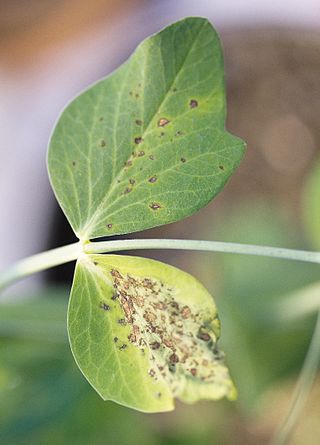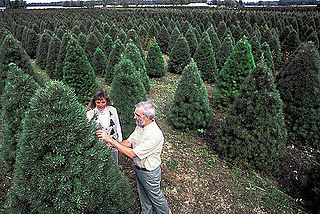
Pinus nigra, the Austrian pine or black pine, is a moderately variable species of pine, occurring across Southern Europe from the Iberian Peninsula to the eastern Mediterranean, on the Anatolian peninsula of Turkey, Corsica and Cyprus, as well as Crimea and in the high mountains of Northwest Africa.

Cronartium ribicola is a species of rust fungus in the family Cronartiaceae that causes the disease white pine blister rust. Other names include: Rouille vésiculeuse du pin blanc (French), white pine Blasenrost (German), moho ampolla del pino blanco (Spanish).

Diplodia tip blight, also known as Sphaeropsis blight, is a widespread disease affecting conifers caused by an opportunistic fungal pathogen, Diplodia sapinea. It is found in “both hemispheres between the latitudes 30° and 50° north and south". The diseases symptoms include: damping off and collar rot of seedlings, stem canker, root disease, and, most commonly, shoot blight. These symptoms have caused significant economic loss to nurseries and pine plantations. In a nursery in the north-central United States, losses of 35% have been reported. Shoot blight and eventual die back can cause a reduction of marketable volume in timber by 63%. Infection of terminal shoots can result in dead-top which significantly limits the usable length of the tree trunk. The presence of the pathogen in concert with severe weather conditions can lead to extreme loss. Following a severe hailstorm in South Africa, nearly 5,000 acres of pine plantation were infected with Diplodia tip blight. It was necessary to prematurely harvest large swaths of the plantations resulting in a loss of 45%. Areas that were not harvested prematurely still suffered an average timber loss of 11%.

Rhizoctonia solani is a species of fungus in the order Cantharellales. Basidiocarps are thin, effused, and web-like, but the fungus is more typically encountered in its anamorphic state, as hyphae and sclerotia. The name Rhizoctonia solani is currently applied to a complex of related species that await further research. In its wide sense, Rhizoctonia solani is a facultative plant pathogen with a wide host range and worldwide distribution. It causes various plant diseases such as root rot, damping off, and wire stem. It can also form mycorrhizal associations with orchids.

Mycosphaerella brassicicola is a plant pathogen. The pathogen is the teleomorph phase of an ascomycete fungus, which causes the ring spot disease of brassicas. The supplementary anamorph phase Asteromella brassicae produces conidia through its asexual reproduction, however these spores are not confirmed to cause disease in host plants.

Diaporthe helianthi is a fungal pathogen that causes Phomopsis stem canker of sunflowers. In sunflowers, Phomopsis helianthi is the causative agent behind stem canker. Its primary symptom is the production of large canker lesions on the stems of sunflower plants. These lesions can eventually lead to lodging and plant death. This disease has been shown to be particularly devastating in southern and eastern regions of Europe, although it can also be found in the United States and Australia. While cultural control practices are the primary method of controlling for Stem Canker, there have been a few resistant cultivars developed in regions of Europe where the disease is most severe.
Mycosphaerella angulata is a fungal plant pathogen infecting muscadine grapes. This pathogen causes the common disease angular leaf spot. Mycosphaerella angulate is an ascomycete in the fungi kingdom.
Mycosphaerella berkeleyi is a fungal plant pathogen. It is the causal agent of the peanut foliar disease Late Leaf Spot.

Didymella pinodes is a hemibiotrophic fungal plant pathogen and the causal agent of ascochyta blight on pea plants. It is infective on several species such as Lathyrus sativus, Lupinus albus, Medicago spp., Trifolium spp., Vicia sativa, and Vicia articulata, and is thus defined as broadrange pathogen.
The plant pathogenic fungus Leucostoma kunzei is the causal agent of Leucostoma canker, a disease of spruce trees found in the Northern Hemisphere, predominantly on Norway spruce and Colorado blue spruce. This disease is one of the most common and detrimental stem diseases of Picea species in the northeastern United States, yet it also affects other coniferous species. Rarely does it kill its host tree; however, the disease does disfigure by killing host branches and causing resin exudation from perennial lesions on branches or trunks.

Ascochyta pisi is a fungal plant pathogen that causes ascochyta blight on pea, causing lesions of stems, leaves, and pods. These same symptoms can also be caused by Ascochyta pinodes, and the two fungi are not easily distinguishable.

Rhabdocline pseudotsugae is a fungal plant pathogen. The pathogen, along with Rhabdocline weirii causes Rhabdocline needlecast; R. weirii only affects Douglas-fir trees. The disease causes the needles of the tree to discolor and eventually fall from the tree. It was originally common to the Rocky Mountain states of the United States but has since spread to Europe. Infections usually start in the spring or early summer and can change the color of the foliage to a variety of hues. The fungus produces apothecia that are normally found on the underside of needles but they also occur on the topside as well.

Pine and fir trees, grown purposely for use as Christmas trees, are vulnerable to a wide variety of pests, weeds and diseases. Many of the conifer species cultivated face infestations and death from such pests as the balsam woolly adelgid and other adelgids. Aphids are another common insect pest. Christmas trees are also vulnerable to fungal pathogens and their resultant illnesses such as root rot, and, in the U.S. state of California, sudden oak death. Douglas-fir trees in particular are vulnerable to infections from plant pathogens such as R. pseudotsugae.

Didymascella thujina is an ascomycete fungus in the family Helotiaceae. D. thujina causes cedar leaf blight, a leaf disease, on western red cedar and white cedar (T. occidentalis).

Armillaria novae-zelandiae is a species of mushroom-forming fungus in the family Physalacriaceae. This plant pathogen species is one of three Armillaria species that have been identified in New Zealand.

Fusarium circinatum is a fungal plant pathogen that causes the serious disease pitch canker on pine trees and Douglas firs. The most common hosts of the pathogen include slash pine, loblolly pine, Monterey pine, Mexican weeping pine, and Douglas fir. Like other Fusarium species in the phylum Ascomycota, it is the asexual reproductive state of the fungus and has a teleomorph, Gibberella circinata.

Ascochyta blights occur throughout the world and can be of significant economic importance. Three fungi contribute to the ascochyta blight disease complex of pea. Ascochyta pinodes causes Mycosphaerella blight. Ascochyta pinodella causes Ascochyta foot rot, and Ascochyta pisi causes Ascochyta blight and pod spot. Of the three fungi, Ascochyta pinodes is of the most importance. These diseases are conducive under wet and humid conditions and can cause a yield loss of up to fifty percent if left uncontrolled. The best method to control ascochyta blights of pea is to reduce the amount of primary inoculum through sanitation, crop-rotation, and altering the sowing date. Other methods—chemical control, biological control, and development of resistant varieties—may also be used to effectively control ascochyta diseases.

Pine-pine gall rust, also known as western gall rust, is a fungal disease of pine trees. It is caused by Endocronartium harknessii, an autoecious, endocyclic, rust fungus that grows in the vascular cambium of the host. The disease is found on pine trees with two or three needles, such as ponderosa pine, jack pine and scots pine. It is very similar to pine-oak gall rust, but its second host is another Pinus species. The fungal infection results in gall formation on branches or trunks of infected hosts. Gall formation is typically not detrimental to old trees, but has been known to kill younger, less stable saplings. Galls can vary from small growths on branch extremities to grapefruit-sized galls on trunks.

Cyclaneusma is a fungal disease that is a part of the phylum, Ascomycota. It infects plants that are of pine classification. After infection by Cyclaneusma, most pines do not display symptoms until 10 months after the initial infection. Symptoms include needles developing yellow spots, horizontal brown bands around the needles, swelling of needles, and off-white fruiting bodies formed on infected needles. Because Cyclaneusma is an ascomycete it produces two spore types, an asexual (conidiomata) and sexual (ascomycota) spore. Controlling Cyclaneusma has presented a challenge as the disease can survive on both living and dead needles during the winter months. Effective management methods include planting new pines in non-shaded, well drainable soil as well as spraying fungicide. Cyclaneusma Needle Cast is an important fungal disease because it directly impacts the commercial value of decorative pines as well as lumber.
Brenda D. Wingfield is a South African Professor of genetics and previous Deputy Dean of the University of Pretoria. She is known for her genetic studies of fungal tree pathogens.















